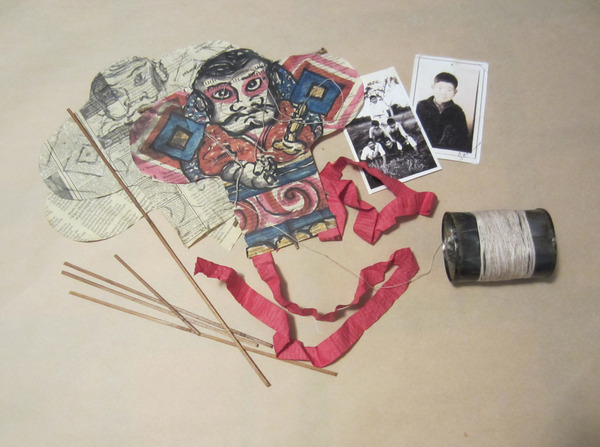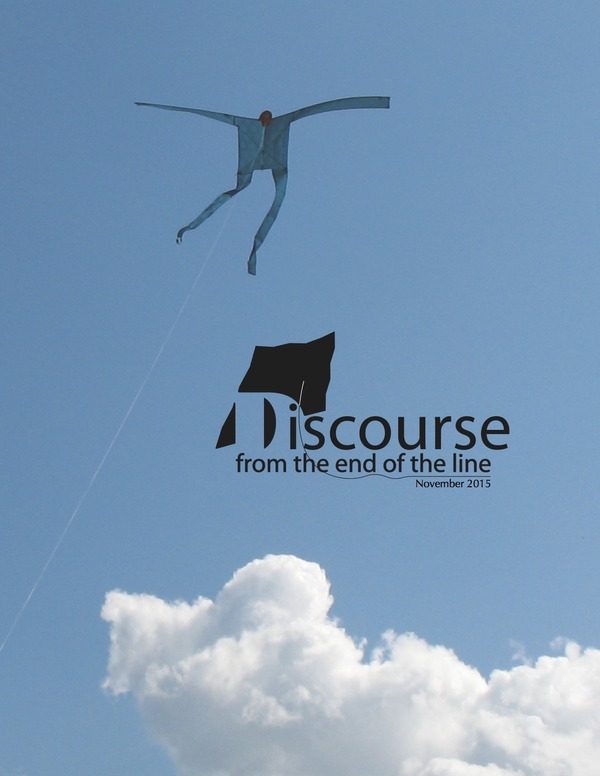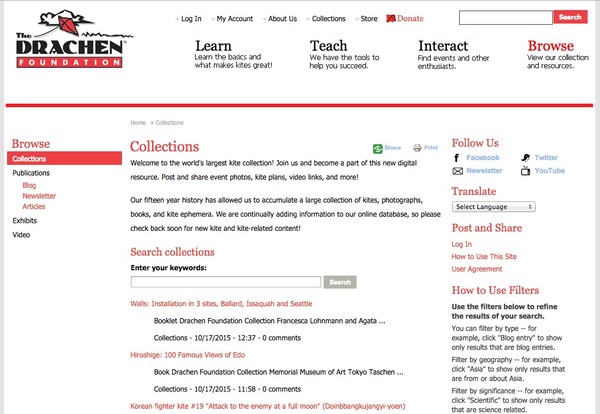Just Released: Discourse Issue 21
In the fall/winter issue of Discourse: from the end of the line, visit the 2015 American Kitefliers Association (AKA) Convention, read about the 1988 trip to the birthplace of kites that started the Drachen Foundation, Austrian artist Stephanie Rauchwarter shares the workflow of building her unique art kites, Scott Skinner reviews Kites, The Art of Using Natural Materials by John Browning, Tom D. Crouch revisits his 1999 essay on the Wright Brothers’ early kite experiments, and we profile important Japanese kitemaker Mikio Toki.
Download and read Discourse Issue 21 > Download PDF
The Magic of Kitemaking
Seattle’s Greg Kono has been a leading art kite artist for decades. After a family reunion where he made kites for the event, his newfound interest in tethered flight brought him to a Drachen Foundation kite workshop. There he stood, amazed that there was an organization focusing on kites. From that point on, Greg became a very important part of the Drachen Foundation, leading art kite workshops all over the world, having exhibitions of his kiteworks, and being a fabulous ambassador of paper and bamboo flight. This is the story of a kite need for a small Auburn, Washington museum and how Greg Kono used his kitemaking expertise to help!
From: Patricia Cosgrove, museum director of the White River Valley Museum
(This small community museum captures the history and culture of the Auburn, Washington area, and it is one of the best small community museums in the state. The director, Patricia Cosgrove, has a wonderful eye for story telling and recreates the richest museum exhibits of the past, mixing fact with actual artifacts. In this correspondence with Greg Kono, she outlines her kiting needs.)
We are putting together some ‘hands on, investigative’ displays to install in our permanent exhibits. One consists of a chest of drawers in an exhibit scene depicting a c. 1920s Japanese American family’s farmhouse. We plan on filling the drawers with things typical of the family—some items typical American things, some pieces more unique to a family of Japanese heritage. Visitors can open the drawers and look in—it is a process of discovery.They cannot remove the items as there will be a layer of glass over the contents.
We want to include a small kite that a Japanese American family might have made in that era. It has to fit into a drawer that is 12 inches deep, 15 inches wide and 3 inches tall. It should include the string and look ready to use and/or in process of being made.
Can you fabricate such a kite for us? It can be VERY modest, homey looking and of traditional, easy to locate materials from that 1920s era. It doesn’t have to fool a kite historian. It just needs to say to kids, “Oh, look, the family in this house made kites, kind of like mine, but different.”
Greg’s Reply:
Yes, it sounds like a fun challenge! I have a couple of ideas. One is a handmade Boy’s Day koi windsock (not a kite). Our family used to fly them on our farm. The other is a traditional Japanese 6 sided rokaku or rectangular kaku-dako kite. Both could be made from repurposed 1920s newspaper (or plain washi paper) painted over with sumi ink and watercolor and framed with bamboo. The artwork on the kite could be a Daruma face or other simple Japanese design. The big challenge would be to create the patina and fade to appear from the 1920s. The winder would just be an old worn wooden slat from a produce box. Do either of these ideas appeal to what you are looking for? And do you have any local vintage newspapers from that era that I can scan or get a copy of?
From: Patricia Cosgrove
I am so glad you think this an interesting challenge. I believe we may have newspapers of that kind and will let you know in a day or so. The painted face would be a real interesting thing to discover in a drawer… The trick is to make sure they fit in the small area. More later!
Greg’s Reply:
Here is an image of the finished product. The kite I decided to do is a simplified mini yakko-dako, a popular New Years kite that was also thought to bring good luck. It measures 9” tall x 10” wide. I used a current newspaper stained lightly with coffee, colored with water colors, markers and left out in the sun for a few days. The winder is an aged and bent tomato paste can and the bamboo has a light stain to give it an aged look as well. I scanned a couple of photos of my Dad, Uncle and few of their friends taken in the 1930s that you are welcome to add to the display.

Greg Kono
I could imagine my grandfather making something similar and my dad crushing the tin can winder from playing with it hard.
One’s Own Kites and Kite Collection
I am often asked to make sense of peoples’ kites and their collections. These requests can mount up, but each represents an important part of an individual’s history with kites and an important piece of the story of the kiting community. As many of you know, the Drachen Foundation is focused on documenting and uploading kite-related photos and artifacts and stories about kites and kiting people to our website. This is an ongoing process and represents several lifetimes of work! Knowing that the world of kiting is much bigger than the capacity of any single organization, the website was designed to allow individuals to upload their own kites, collections, and information – allowing each person to personalize the information and create a lasting record of their own.
It is easy to do. Just create your own access and password and upload one or many items. It is a good way to document your kiting years and create a legacy of what you have done in kiting for generations to come.
How to get started:
1. Photograph one or two of your kites. (Just do it!)
2. Then visit: www.drachen.org/collections
3. Scroll down to "Create an account" (bottom right) and create your own login!
4. Read “How to Use This Site” to learn more.
5. When creating an item, fill out the template, define your item, and write up a description. The description block will take as much information as you want to write! Upload one or more photos!
6. Then email info@drachen.org and let us know that you have completed an entry, and you will hear from us!
Fair Winds,
The Drachen Foundation



